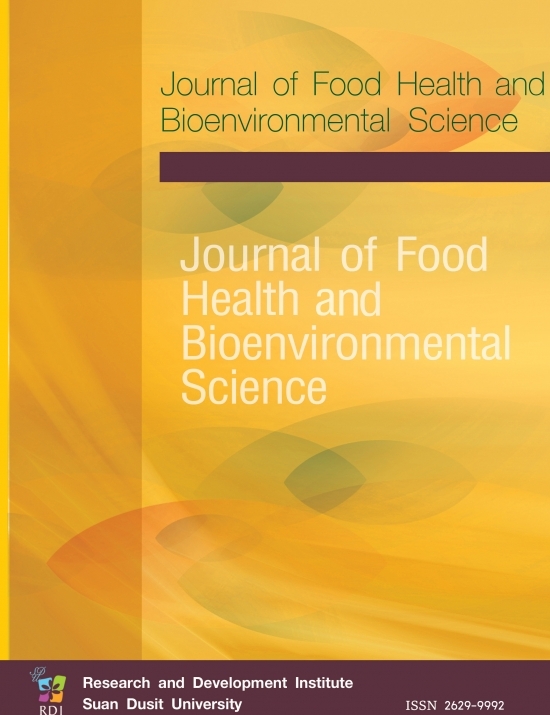Optimizing Trichoderma longibrachiatum Pellets with Spent Mushroom Substrate: A Study on Conidial Viability and Shelf Life
Keywords:
Trichoderma longibrachiatum, Spent mushroom substrate, Biological controlAbstract
Spent mushroom substrate (SMS), a byproduct of mushroom production, is commonly used as growth media in plant nurseries and horticulture. This study aimed to develop Trichoderma longibrachiatum pellets using SMS to extend conidial shelf life and enhance efficiency for biological control. T. longibrachiatum strains isolated from paddy field soils in Phayao and Chiang Rai provinces were formulated into pellets using SMS and diatomaceous earth (DE) across four formulations. Each formulation contained viable conidia of T. longibrachiatum at a concentration of 2×10⁷ conidia/mL of distilled water, with varying ratios of SMS and DE. The pellets were characterized based on weight, diameter, water solubility, and conidial shelf life after storage at 4°C for 60 days. Formulations 2–4 showed a significant increase in weight compared to Formulation 1, depending on the percentage of DE. The average pellet diameters ranged from 9.40 ± 0.27 mm (Formulation 1) to 10.89 ± 0.65 mm (Formulation 4). Water solubility tests revealed significant differences among the formulations (P < 0.05). Formulation 1 had the longest dissolution time (11.12 ± 0.89 min), while Formulation 4 had the shortest (0.26 ± 0.08 min). All formulations maintained conidial viability when cultured on Trichoderma Selective Media (TSM). Based on water solubility and conidial viability, Formulation 4 emerged as the optimal formulation for potential use in biological control applications in agriculture.
References
Abdelgaleil, S.A.M, Gad, H.A., Hamza, A.F., & Al-Anany, M.S. (2021). Insecticidal efficacy of two inert dusts and Trichoderma harzianum, applied alone or in combination, against Callosobruchus maculatus and Callosobruchus chinensis on stored cowpea seeds. Crop Protection, 146, 105656.
Chen, L., Hao, D., Dou, K., Lang, B., Wang, X., Li, Y., & Chen, J. (2023). Preparation of high water-soluble Trichoderma co-culture metabolite powder and its effects on seedling emergence rate and growth of crops. Journal of Fungi, 9(7), 767-785.
Francisco, E.A., Mochi, D.A., Correia, A.C.B., & Monteiro, A.C. (2006). Influence of culture media in viability test of conidia of entomopathogenic fungi. Ciencia Rural, 36(4), 1309-1312.
Fravel, D.R. (2005). Commercialization and implementation of biocontrol. Annual Review of Phytopathology, 43, 337-359.
Gams, W., & Bissett, J. (1998). Morphology and identification of Trichoderma. In C.P. Kubicek, & G.E. Harman (Eds.), Trichoderma and Gliocladium (pp. 3-34). London, England: Taylor and Francis.
Hermosa, R., Viterbo, A., Chet, I., & Monte, E. (2012). Plant-beneficial effects of Trichoderma and of its genes. Microbiology, 158(1), 17-25.
Kawicha, P., Natino, W., & Phatthanasan, W. (2020). Development of encapsulated granule of Trichoderma-based bioproduct for tomato Fusarium wilt disease control. Thai Journal of Science and Technology, 9(6), 832-843.
Küçük, Ç., & Kıvanç, M. (2005). Effect of formulation on the viability of biocontrol agent, Trichoderma harzianum conidia. African Journal Biotechnology, 4(5), 483-486.
Kumar, S., Thakur, M., & Rani, A. (2014). Trichoderma: Mass production, formulation, quality control, delivery and its scope in commercialization in India for the management of plant diseases. African Journal of Agricultural Research, 9(53), 3838-3852.
Kumar, S., Chugh, R.K., & Singh, J. (2022). Impact of spent mushroom substrate integration with Trichoderma harzianum on yield and gummosis disease incidence in bottle gourd (Lagenaria siceraria). International Journal of Plant & Soil Science, 34(18), 69-76.
Luz, C., Rodigues, J., & Rocha, L.F.N. (2012). Diatomaceous earth and oil enhance effectiveness of Metarhizium anisopliae against Triatoma infestans. Acta Tropica, 122, 29-35.
Martinez, Y., Ribera, J., Schwarze, F.W.M.R., & France, K.D. (2023). Biotechnological development of Trichoderma‑based formulations for biological control. Applied Microbiology and Biotechnology, 107, 5595-5612.
Monaco, C., Perello, A., Alippi, H.E., & Pasquare, A.O. (1991). Trichoderma spp.: A biocontrol agent of Fusarium spp. and Sclerotium rolfsii by seed treatment. Advances in Horticultural Science, 5(3), 92–95.
Mukhopadhyay, R., & Kumar, D. (2020). Trichoderma: a beneficial antifungal agent and insights into its mechanism of biocontrol potential. Egypt Journal of Biological Pest Control, 30, 133.
Oliveir, D.G.P., Pauli, G., Mascarin, G.M., & Delalibera, I. (2015). A protocol for determination of conidial viability of the fungal entomopathogens Beauveria bassiana and Metarhizium anisopliae from commercial products. Journal of Microbiological Methods, 119, 44-52.
Sukyai, S., Suwannarach, N., & Nuangmek, W. (2020). Study of suitable materials for bioformulation development of endophytic fungus Trichoderma sp. (L3I1). Khon Kaen Agricultural Journal, 48(1), 331-336.
Symondson, W.O.C., Sunderland, K.D., & Greenstone, M.H. (2002). Can generalist predators be effective biocontrol agents? Annual Review of Entomology, 47, 561–594.
Tang, F.H.M., Lenzen, M., McBratney, A., & Maggi, F. (2021). Risk of pesticide pollution at the global scale. Nature Geoscience, 14, 206-210.
Zhu, J., Wang, J., Ding, Y., Liu, B., & Xiao, W. (2018). A systems-level approach for investigating organophosphorus pesticide toxicity. Ecotoxicology and Environmental Safety, 149, 26–35.
Ziaee, M., Ebadollahi, A., & Wakil, W. (2021). Integrating inert dusts with other technologies in stored products protection. Toxin Reviews, 40(4), 404–419.
Downloads
Published
How to Cite
Issue
Section
License
Copyright (c) 2024 Journal of Food Health and Bioenvironmental Science

This work is licensed under a Creative Commons Attribution-NonCommercial-NoDerivatives 4.0 International License.








